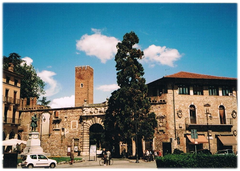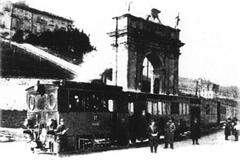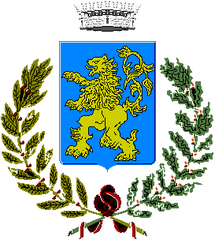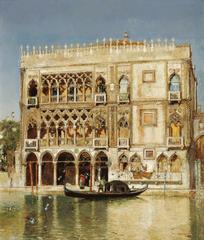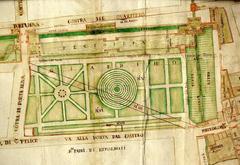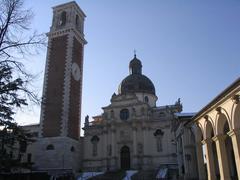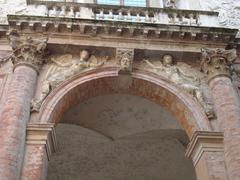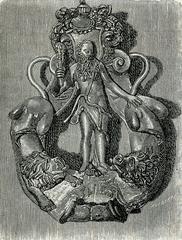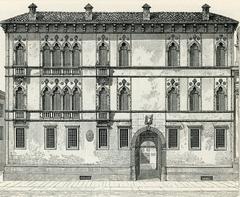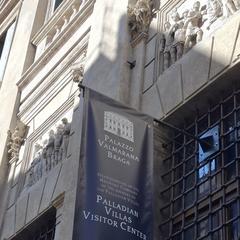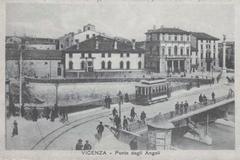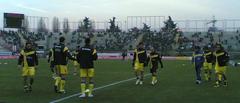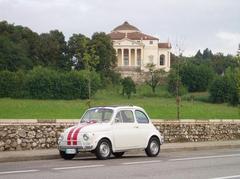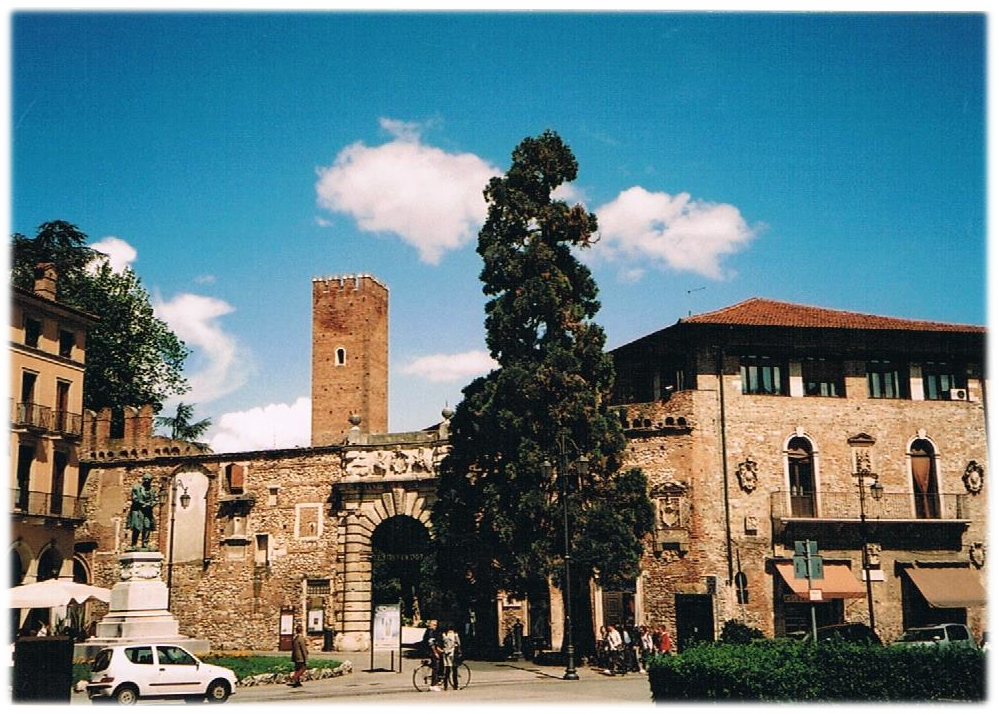
Teatro Olimpico Visiting Hours, Tickets, and Historical Significance
Date: 18/07/2024
Introduction
Teatro Olimpico, located in Vicenza, Italy, stands as a testament to the brilliance of Renaissance architecture and the enduring legacy of Andrea Palladio. Designed in 1580 by Palladio and completed by his student Vincenzo Scamozzi, this historic theater is renowned for its innovative use of perspective and classical design elements. As the oldest surviving enclosed theater in the world, Teatro Olimpico offers visitors a unique glimpse into the past, combining architectural ingenuity with cultural significance (UNESCO).
The theater’s design draws inspiration from ancient Roman theaters, incorporating Renaissance ideals that make it a unique blend of historical and contemporary styles. The semi-elliptical seating arrangement and intricate stage set, known as the ‘Scamozzi Perspective,’ create an illusion of depth that continues to captivate audiences today. Inaugurated with a performance of Sophocles’ ‘Oedipus Rex’ in 1585, Teatro Olimpico quickly became a cultural hub, hosting elaborate productions that set new standards for European theater (Italy Magazine).
Despite periods of neglect, the theater has been meticulously restored and now enjoys UNESCO World Heritage status. It continues to host a variety of performances, including classical plays and concerts, making it a vibrant part of Vicenza’s cultural life. This guide aims to provide comprehensive information on visiting Teatro Olimpico, including its history, architectural features, visitor tips, and nearby attractions, ensuring a memorable experience for all who explore this architectural gem (Teatro Olimpico).
Table of Contents
- Introduction
- History of Teatro Olimpico
- Visitor Information
- Special Events and Guided Tours
- Photographic Spots
- FAQ
- Conclusion
History of Teatro Olimpico
Origins and Construction
Teatro Olimpico was designed by the renowned architect Andrea Palladio in 1580, commissioned by the Accademia Olimpica, a society of scholars and artists. Palladio, who was already famous for his architectural works, aimed to create a structure that would emulate the grandeur of ancient Roman theaters. Unfortunately, Palladio passed away in August 1580, shortly after construction began, leaving the project incomplete. The task of finishing the theater fell to his student, Vincenzo Scamozzi, who adhered closely to Palladio’s original designs (Teatro Olimpico).
Architectural Design
The Teatro Olimpico is celebrated for its innovative design, which combines classical elements with Renaissance aesthetics. The theater’s most striking feature is its permanent stage set, known as the “Scamozzi Perspective,” which creates an illusion of a long street receding into the distance. This optical illusion is achieved through the use of forced perspective, a technique that Scamozzi mastered. The stage set is adorned with intricate sculptures and architectural details that mimic the streets of ancient Thebes, as the theater was initially intended to host a production of Sophocles’ “Oedipus Rex” (UNESCO).
Inauguration and Early Performances
The Teatro Olimpico was inaugurated on March 3, 1585, with a performance of “Oedipus Rex,” marking a significant event in the history of theater. The inaugural performance was a grand affair, attended by the elite of Vicenza and beyond. The theater’s design and acoustics were praised, and it quickly became a cultural hub. The early performances at Teatro Olimpico were characterized by their elaborate staging and use of innovative theatrical techniques, setting a new standard for theater productions in Europe (Italy Magazine).
Decline and Restoration
Despite its initial success, the Teatro Olimpico experienced periods of neglect and decline. By the 18th century, the theater was rarely used, and its condition deteriorated. However, the 19th and 20th centuries saw renewed interest in preserving this architectural gem. Restoration efforts were undertaken to repair and maintain the theater, ensuring its survival for future generations. These efforts included structural repairs, restoration of the stage set, and improvements to the theater’s acoustics and seating (Vicenza è).
Modern Era and UNESCO Recognition
In the modern era, Teatro Olimpico has regained its status as a cultural landmark. It hosts a variety of performances, including classical plays, concerts, and cultural events. The theater’s unique design and historical significance have made it a popular destination for tourists and scholars alike. In 1994, Teatro Olimpico, along with other Palladian buildings in Vicenza, was designated a UNESCO World Heritage Site, recognizing its outstanding universal value and contribution to the cultural heritage of humanity (UNESCO).
Architectural Features and Innovations
The Teatro Olimpico is renowned for its architectural innovations, which have influenced theater design for centuries. One of the most notable features is the “cavea,” or seating area, which is semi-circular and modeled after ancient Roman theaters. The cavea is divided into tiers, providing excellent sightlines and acoustics for the audience. The theater’s ceiling is painted to resemble the sky, enhancing the illusion of an open-air venue. Additionally, the use of natural light and carefully designed artificial lighting creates a dynamic and immersive experience for spectators (Palladio Museum).
Cultural Significance
The cultural significance of Teatro Olimpico extends beyond its architectural achievements. The theater has played a crucial role in the development of European theater and the preservation of classical drama. It has served as a venue for the revival of ancient Greek and Roman plays, as well as the promotion of Renaissance humanism. The Accademia Olimpica, which continues to oversee the theater, has been instrumental in fostering a spirit of intellectual and artistic inquiry. The theater’s enduring legacy is a testament to the vision of Andrea Palladio and the dedication of those who have worked to preserve it (Accademia Olimpica).
Visitor Information
Visiting Hours and Tickets
Teatro Olimpico is open to visitors from Tuesday to Sunday. The visiting hours are typically from 9:00 AM to 5:00 PM, but it’s advisable to check the official website for the most up-to-date information. Tickets can be purchased at the entrance or online through the official Teatro Olimpico website. Ticket prices vary, with discounts available for students, seniors, and groups.
Travel Tips
Vicenza is well-connected by train and bus services, making it easy to reach Teatro Olimpico. The theater is located in the city center, within walking distance of other major attractions. The best times to visit are during weekdays and off-peak seasons to avoid crowds. It’s also recommended to explore nearby cafes and restaurants to experience local cuisine.
Nearby Attractions
Vicenza is rich in historical and cultural sites. Some nearby attractions include:
- Piazza dei Signori: A historic square featuring the Basilica Palladiana.
- Villa La Rotonda: Another architectural masterpiece by Andrea Palladio.
- Museo Civico di Palazzo Chiericati: A museum housing an impressive collection of art and artifacts.
Special Events and Guided Tours
Teatro Olimpico hosts a variety of special events, including theater festivals, classical concerts, and academic conferences. Guided tours are available, offering insights into the theater’s history, architecture, and cultural impact. These tours can be booked in advance through the official website or at the venue.
Photographic Spots
For photography enthusiasts, some of the best spots to capture the beauty of Teatro Olimpico include:
- The main entrance, offering a grand view of the theater’s facade.
- Inside the cavea, providing an excellent angle of the stage set and ceiling.
- The stage itself, showcasing the intricate details of the Scamozzi Perspective.
FAQ
Q: What are the visiting hours for Teatro Olimpico? A: Teatro Olimpico is open from Tuesday to Sunday, typically from 9:00 AM to 5:00 PM. Check the official website for the most current information.
Q: How much do tickets cost? A: Ticket prices vary, with discounts available for students, seniors, and groups. Tickets can be purchased at the entrance or online.
Q: What is the best way to get to Teatro Olimpico? A: Vicenza is well-connected by train and bus. The theater is located in the city center, within walking distance of other major attractions.
Q: Are guided tours available? A: Yes, guided tours are available and can be booked in advance through the official website or at the venue.
Conclusion
Teatro Olimpico is a fascinating destination that offers a unique blend of history, architecture, and culture. Whether you’re a history buff, an architecture enthusiast, or simply looking for an enriching experience, a visit to Teatro Olimpico is sure to be memorable. Don’t forget to check out our mobile app for more travel tips, follow us on social media for updates, and explore other related posts on our site.
References
- UNESCO. (1994). Teatro Olimpico
- Italy Magazine. (n.d.). Italy Magazine
- Teatro Olimpico. (n.d.). Teatro Olimpico
- Palladio Museum. (n.d.). Palladio Museum
- Vicenza è. (n.d.). Vicenza è
